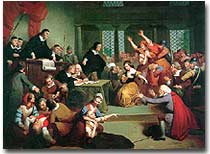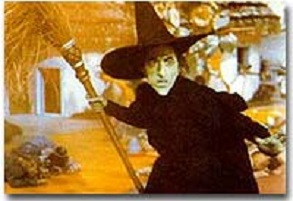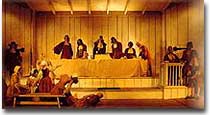3g. Witchcraft in Salem

George Jacobs Sr. and his granddaughter Margaret were both accused of witchcraft, but Margaret managed to escape harm by claiming that Grandpa was indeed a witch. He was convicted and hanged in August 1692.
Surely the Devil had come to Salem in 1692. Young girls screaming and barking like a dog? Strange dances in the woods? This was behavior hardly becoming of virtuous teenage maidens. The town doctor was called onto the scene. After a thorough examination, he concluded quite simply — the girls were bewitched. Now the task was clear. Whomever was responsible for this outrage must be brought to justice.
The ordeal originated in the home of Salem's Reverend Samuel Parris. Parris had a slave from the Caribbean named Tituba. Several of the town's teenage girls began to gather in the kitchen with Tituba early in 1692. As winter turned to spring the townspeople were aghast at the behaviors exhibited by Tituba's young followers. They were believed to have danced a black magic dance in the nearby woods. Several of the girls would fall to the floor and scream hysterically. Soon this behavior began to spread across Salem. Ministers from nearby communities came to Salem to lend their sage advice. The talk turned to identifying the parties responsible for this mess.

"There's no place like Salem. There's no place like Salem..."
Puritans believed that to become bewitched a witch must draw an individual under a spell. The girls could not have possibly brought this condition onto themselves. Soon they were questioned and forced to name their tormentors. Three townspeople, including Tituba, were named as witches. The famous Salem witchcraft trials began as the girls began to name more and more community members.
Evidence admitted in such trials was of five types. First, the accused might be asked to pass a test, like reciting the Lord's Prayer. This seems simple enough. But the young girls who attended the trial were known to scream and writhe on the floor in the middle of the test. It is easy to understand why some could not pass.
Second, physical evidence was considered. Any birthmarks, warts, moles, or other blemishes were seen as possible portals through which Satan could enter a body.
Witness testimony was a third consideration. Anyone who could attribute their misfortune to the sorcery of an accused person might help get a conviction.
Fourth was spectral evidence. Puritans believed that Satan could not take the form of any unwilling person. Therefore, if anyone saw a ghost or spirit in the form of the accused, the person in question must be a witch.

The Trial of Rebecca Nurse
Last was the confession. Confession seems foolhardy to a defendant who is certain of his or her innocence. In many cases, it was the only way out. A confessor would tearfully throw himself or herself on the mercy of the town and court and promise repentance. None of the confessors were executed. Part of repentance might of course include helping to convict others.
As 1692 passed into 1693, the hysteria began to lose steam. The governor of the colony, upon hearing that his own wife was accused of witchcraft ordered an end to the trials. However, 20 people and 2 dogs were executed for the crime of witchcraft in Salem. One person was pressed to death under a pile of stones for refusing to testify.
No one knows the truth behind what happened in Salem. Once witchcraft is ruled out, other important factors come to light. Salem had suffered greatly in recent years from Indian attacks. As the town became more populated, land became harder and harder to acquire. A smallpox epidemic had broken out at the beginning of the decade. Massachusetts was experiencing some of the worst winters in memory. The motives of the young girls themselves can be questioned. In a society where women had no power, particularly young women, is it not understandable how a few adolescent girls, drunk with unforeseen attention, allowed their imaginations to run wild? Historians make educated guesses, but the real answers lie with the ages.






